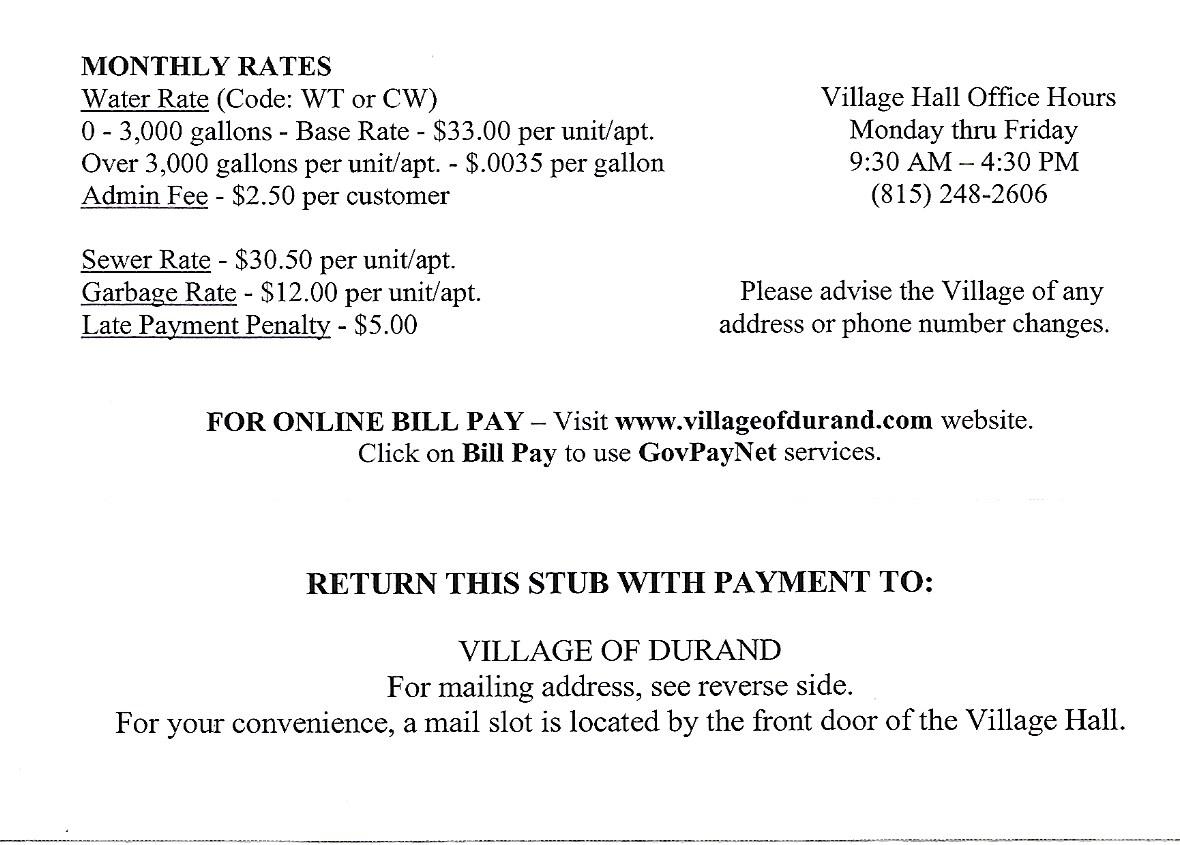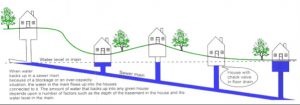Water, Sewer and Refuse (Billing & FAQ)
Property owners receive one, convenient postcard billing statement for Water, Sewer and Refuse services. Payment of services are due by the last day of the month. Late payments result in a $5.00 penalty. There is an administrative fee of $2.50 per customer.
Sewer and waste removal are flat fees, while each property or each unit on multi unit properties operates on a water meter.
Water: Water usage is calculated by reading the water meter from the road electronically each month. The monthly cost is figured using the previous month ending reading and the current month ending reading. The water rate is figured as 0-3,000 gallons of water usage=Base Rate $33.00 per unit/apt and anything over 3,000 gallons per unit/apt=$.0035 per gallon.
Sewer: Sewer rates are $33.50
Refuse: The Village of Durand contracts with Waste Management for waste removal within the Village limits and pays the entire billed amount each month on behalf of the residents. The $16.10 per unit/apt is collected from the resident on the Utility bill.

Breakdown of Utility Bill Pricing
IMPORTANT INFORMATION ABOUT LEAD IN YOUR DRINKING WATER
Steps You Can Take To Reduce Your Exposure To Lead In Your Water
IMPORTANT INFORMATION ABOUT LEAD IN YOUR DRINKING WATER
[Village of Durand] found elevated levels of lead in drinking water in two homes/buildings. Lead can cause serious health problems, especially for pregnant women and children 6 years and younger. Please read this notice closely to see what you can do to reduce lead in your drinking water.
Health Effects of Lead
Lead can cause serious health problems if too much enters your body from drinking water or other sources. It can cause damage to the brain and kidneys, and can interfere with the production of red blood cells that carry oxygen to all parts of your body. The greatest risk of lead exposure is to infants, young children, and pregnant women. Scientists have linked the effects of lead on the brain with lowered IQ in children. Adults with kidney problems and high blood pressure can be affected by low levels of lead more than healthy adults. Lead is stored in the bones and it can be released later in life. During pregnancy, the child receives lead from the mother’s bones, which may affect brain development.
Sources of Lead
The primary sources of lead exposure for most children are deteriorating lead-based paint, lead-contaminated dust, and lead-contaminated residential soil. Exposure to lead is a significant health concern, especially for young children and infants whose growing bodies tend to absorb more lead than the average adult. Infants that drink formula prepared with lead-contaminated water are at a greater risk because of the large volume of water they drink relative to their body size. Lead is rarely found in source water, but enters tap water through corrosion of plumbing materials. Homes built before 1986 are more likely to have lead pipes, fixtures and solder.
Steps You Can Take To Reduce Your Exposure To Lead In Your Water
If the level of lead found in your drinking water is above 15 ppb or if you are concerned about the lead levels at your location, there are several things you can do:
- Run your water to flush out lead. If water hasn’t been used for several hours, run water from your kitchen tap or whatever tap you use for drinking and cooking for at least 3 minutes and it becomes cold or reaches a steady temperature before using it for drinking or cooking. This will help flush lead-containing water from the pipes. In order to conserve water, you can fill multiple containers after flushing for drinking, cooking, and preparing baby formula.
- Bottled drinking water should be used by pregnant women, breast-feeding women, young children, and formula-fed infants at homes where lead has been detected at levels greater than 15 ppb.
- Use cold water for drinking, cooking, and preparing baby formula. Do not cook with or drink water from the hot water tap; lead dissolves more easily into hot water.
- Do not use water from the hot water tap to make baby formula.
- Do not boil water to remove lead. Boiling water will not reduce lead.
- Look for alternative sources or treatment of water.
- Test your water for lead. Call us at the number below to find out how to get your water tested for lead.
- Identify if your plumbing fixtures contain lead. New brass faucets, fittings, and valves, including those advertised as “lead-free,” may contribute lead to drinking water. As of June 19, 1986, new or replaced water serviced lines and new household plumbing materials could not contain more than 8% lead. Lead content was further reduced on January 4, 2014, when plumbing materials must now be certified as “lead-free” to be used (weighted average of wetted surface cannot be more than 0.25% lead). Consumers should be aware of this when choosing fixtures and take appropriate precautions.
What Happened? What is Being Done?
Flushing Water Mains and increased testing
For More Information Call 1-815-248-2201 For more information on reducing lead exposure around your home/building and the health effects of lead, visit EPA’s Web site at www.epa.gov/lead or contact your health care provider.
Village of Durand distributed 11-14-2022.
SEWER FAQ
Lead the Fight Against Back Ups!!
Don’t dispose of grease down your drains! Improper disposal of grease can cause major problems in the property owner’s sewer lines, as well as in the District sewer lines. Large amounts of grease cause system interference and clogging of pumping equipment. Raw sewage in the pipes will attach to fats, oils and grease, creating globs that clog sewer lines. These globs of fat and waste are difficult to disinfect at the treatment plant and can allow disease-causing pathogens to enter streams and rivers.
Most people don’t realize the problems they are causing for themselves and the District when they pour fats, oils and grease down the drain.
Why did my sewer back up?
Sewers back-up for two reasons; either the line is blocked or more water is trying to flow into the main than it can hold.
When the main cannot handle all of the water that is coming into it, the water backs up to a higher level. Generally, the water comes up through floor drains, toilets and sinks in the lowest part of the houses that are at the low end of the sewer main. See the diagram below:

(image from Rockford Register Star)
Blockages in sewer mains can happen because the pipes become filled with debris, tree roots grow into the pipes and block the flow, or large objects, such as tree branches and rocks, are dumped into manholes.
Sewer blockages can result from grease used for cooking. Grease can solidify in the sewer lines and restrict other waste from passing through the line. The sources for grease which are common in the kitchen exceed just meat fat.
The lines can also be blocked by items which are improperly flushed down the drain or toilet. Examples include disposable diapers, paper towels, feminine hygiene products, and washing machine lint.
A common cause of overcapacity flooding is the illegal connection of sump pumps to the sewer lines. Just 10 sump pumps can overfill the average residential sewer main during a storm. Gutters and drain tiles which are improperly diverted to the sanitary sewer may also lead to overcapacity flooding. The Sanitary District utilizes a Clear Water Inspection program to identify and correct these types of illegal connections.
Who's responsible for fixing my sewer
The Sanitary District is responsible for the maintenance of the sewer mains that run in the streets.
Individual property owners are responsible for the maintenance of the lines running from houses to the sewer mains.
Property owners also are responsible for any damage caused by blockages of the lines running from the house to the street. The District is responsible for problems in its lines only if the problem is due to negligence on the District’s part. There is no way for the District to control inappropriate debris from being placed into the sewer system.
Damage to your home from sewer backups might be covered by your homeowner or tenant’s insurance. Check with your agent.
If a problem is in the line from the house to the street the homeowner must first contact a licensed plumber to clear or repair your connector line. If the contractor is unable to open the line and the problem is found to be within the public right-of-way, the contractor may call the Sanitary District for assistance.
Simple Rules to Avoid Sewer Backup Problems
Follow these simple rules to avoid sewer back-up problems, costly, labor-intensive cleaning and repairs and environmental damage:
- Never pour grease down the drain. Even if you run hot water down the line, the grease cools quickly and solidifies as it moves through the sewer line. Once it cools and solidifies, it catches on roots and rough spots in the pipes, blocking the flow of sewage. This can result in back-ups. Hot water will not solve the problem!
- Pour grease into a metal container, allow it to cool and place it in the garbage. A lid is required on a container holding liquid grease. You can freeze it for easier disposal.
- You can pour cooled grease into a plastic bag.
- Scrape grease and food from dishes and pans prior to washing. This type of waste can be placed in your trash.
- Use a basket or strainer in the sink to catch greasy food scraps.
- Restaurants, grocery stores, and delis are required to have a grease trap or grease interceptor and have it regularly pumped and cleaned.
- Please do not flush wipes or other disposable cleaning cloths (even if they say “Flushable”)
